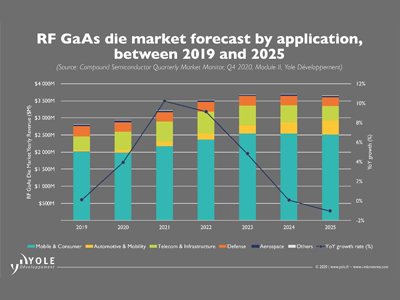Despite the short-term impact as a result of the pandemic, SiC device market revenue continues its growth and is expected to exceed US$3 billion by 2025. EV/HEV is still the killer application for SiC devices. Despite the global slowdown in H1-2020 due to the COVID-19 outbreak, design wins for SiC solutions have recently multiplied, with a bright market outlook for 2019-2020 period.
Yole Développement projects that the GaN business will reach beyond US$680 million in 2025. The adoption of GaN HEMTs for Oppo’s in-box fast charger at the end of 2019 boosted the penetration of this wide bandgap material. The GaN journey has just started with the end-consumer mass market where it will gain volume production.
Total GaN RF3 device market will reach beyond US$2 billion by 2025. Yole Développement announced a 12 percent CAGR between 2019 and 2025. The market is driven by telecom and defense applications. GaN RF devices for military use is expected to increase rapidly. With a revenue expected to exceed US$1 billion by 2025. GaN RF business is not only dependent on OEM technological choices, but also on the geopolitical context.
RF GaAs die market will rise from around US$2.8 billion in 2019 to over US$3.6 billion in 2025. The market is driven by the rise for 5G and Wi-Fi6 demand for handset applications.
5G TELECOM INFRASTRUCTURE: THE GaN ASCENDANCY
“In the dynamic 5G infrastructure market, there is a continuous race for more efficient antenna types. Switching technology from RRH7 to AAS8 will transform the RF front ends from a low number of high-power RF lines to a large number of low-power RF lines,” asserted Ahmed Ben Slimane, PhD, technology & market analyst, Compound Semiconductor Monitors at Yole. Meanwhile, deployment of higher frequencies in the sub-6 GHz as well as in the mm-wave regimes, pushes OEMs to look for new antenna technology platforms with larger bandwidth, higher efficiency and better thermal management. In this context, GaN technology has become a serious competitor to LDMOS9 and GaAs in RF power applications, showing continuous performance and reliability improvement leading, potentially, to a lower cost at the system level. Following its penetration into the 4G LTE telecom infrastructure market, GaN-on-SiC is expected to maintain its strong position in 5G sub-6 Hz RRH implementations. However, in the emerging segment of 5G sub-6 Ghz AAS—massive MIMO deployments—the rivalry between GaN and LDMOS continues. While cost-efficient LDMOS technology carries on with noteworthy progress in high-frequency performance for sub-6 GHz, GaN-on-SiC offers remarkable bandwidth, PAE and power output.
GAAS, A KEY SEGMENT OF THE POWER SEMICONDUCTOR INDUSTRY

The handset market is the big driver for GaAs devices with PA content increasing per phone. In general, 4G LTE cellular phones need to cover up multiple frequency bands, with an increasing number of PAs per phone. The 5G demand for PAs is at least a factor of two more than for 4G. Adding to that the stringent requirements for linearity and power make GaAs the material choice for PAs in the RF FEM. Even though CMOS has lower cost per chip, it will not necessarily have the advantage over GaAs when it comes to modules and performance.
“For mobile connectivity, Wi-Fi 6 began to enter the market in 2019,” explained Poshun Chiu, technology & market analyst, Compound Semiconductors & Emerging Materials at Yole. “Some OEMs launched new phones with Wi-Fi 6: Samsung’s Galaxy S10 in Q1-19, Apple’s iPhone 11 in Q3-19 and in Q1-20 Xiaomi was the first Chinese handset company to have Wi-Fi 6. GaAs solutions are becoming of great interest owing to their linearity and high-power output, compared to traditional solutions,” he added.
THE PROSPERITY OF THE POWER SiC DEVICES: THANKS TO AUTOMOTIVE APPLICATIONS
Since the first commercialization of SiC diodes, the power SiC device market has been driven by power supply applications. Nevertheless, automotive is becoming the killer application, following SiC’s notable adoption for Tesla’s main inverters in 2018. Since than announcements from different carmakers for SiC solution design wins have multiplied. In 2020, BYD has also adopted SiC based main inverter solution for their premium models. Other carmakers, such as Audi, Volkswagen and Hyundai are expected to adopt SiC in their next generation models.
In the prospering SiC power market, the automotive segment is undoubtedly the foremost driver, and as such will hold more than 60 percent of total device market share in 2025.
“However, following the global Covid-19 outbreak, almost all automotive OEMs had to shut down and the supply chain faced significant disruption,” commented Ezgi Dogmus. “In this context, we expect the power SiC market’s Y-o-Y (year over year) growth to slow down to 7 percent in 2020, with a significant impact in Q1-2020 and Q2-2020.”
In addition, the reverse engineering and costing company System Plus Consulting, a Yole Développement company, deeply analyzes the compound semiconductor and power technologies and technical choices made by the leading semiconductor players.
Yole’s Compound Semiconductor Quarterly Market Monitor on SiC and GaN applications has been published every beginning of March (Q1), June (Q2), September (Q3) and December (Q4). The aim of these services is to provide an in-depth coverage of rapidly changing market dynamics and main players’ status and strategy.
The Yole’s Quarterly Market Monitor evolved in Q4-20 and incorporated step by step two modules:
• Module I: GaN and SiC for power electronics applications
• Module II: GaAs and GaN for RF electronics applications
In addition, the market research and strategy consulting company Yole released the annual RF GaN and GaAs technology & market reports: GaN RF Market: Applications, Players, Technology and Substrates 2020 report and GaAs Wafer and Epiwafer Market: RF, Photonics, LED, Display and PV Applications 2020.

